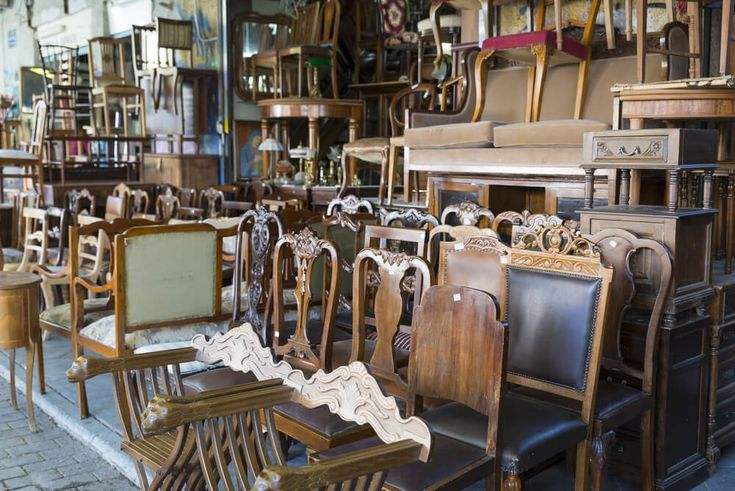Getting rid of a broken chair in Michigan doesn’t have to be a complicated task. Whether you have a wooden chair with a wobbly leg or an office chair that’s seen better days, there are options to suit your needs. You can recycle the materials, donate the chair if it’s still usable, or repurpose it for a new project. If none of these work, there are proper disposal methods you can follow based on local regulations. In this blog post, A&B Junk helps to explore the various ways you can handle a broken chair responsibly and efficiently in Michigan.
Understanding Local Regulations

Before you decide how to dispose of your broken chair, you should familiarize yourself with local regulations and guidelines in your area. Michigan’s waste management practices can vary by county or municipality, so it is essential to check with your local waste management authority or municipality for specific instructions on disposing of furniture.
Local regulations refer to laws and rules set by municipalities, counties, or regions to govern specific activities within their jurisdictions. These may include zoning laws, building codes, business licensing requirements, and health and safety standards. Understanding local regulations is essential for residents and businesses to ensure compliance with legal requirements. Staying informed about local rules helps prevent violations and fosters good relationships with neighbors and local authorities.
Evaluating the Chair’s Condition
Consider the chair’s condition before deciding on a disposal method. If the chair is entirely broken and beyond repair, disposal may be your only option. However, if the chair is only partially damaged and can be fixed or repurposed, you might want to explore other options such as repairing it yourself or donating it to someone who can.
Evaluating a chair’s condition involves assessing its structural integrity, comfort, and aesthetic appeal. Look for signs of wear, such as loose joints, damaged upholstery, or wobbly legs. Consider the age and usage of the chair to determine its lifespan. If a chair is beyond repair, or no longer serves its purpose, it may be time to consider chair removal services. These services can efficiently and responsibly dispose of or recycle old chairs, making room for new furniture and improving overall space management.
Recycling the Chair
Recycling is an excellent option if your chair is made from recyclable materials like metal, wood, or certain plastics. Some recycling centers in Michigan accept furniture items for recycling, so you should contact your local recycling center to see if they accept chairs. If the chair consists of multiple materials, such as wood and metal, you may need to disassemble it so that each material can be appropriately sorted and recycled.
Recycling a chair involves repurposing its materials to reduce waste and environmental impact. Wooden chairs can be stripped and refurbished, while metal parts can be melted down and reused. Upholstered chairs may have their fabric removed for repurposing. When recycling a chair, consider donating it to a thrift store or giving it to someone in need if it’s still in good condition. Proper recycling helps conserve resources and minimizes the chair’s impact on landfills.
Donating the Chair
If the chair is still usable, despite some damage, you can consider donating it to a local charity or thrift store. Many organizations, such as Goodwill and Salvation Army, accept gently used furniture items, even if they need minor repairs. However, make sure to check with the organization first to ensure they are willing to take the chair and understand any specific donation requirements they may have.
Donating a chair is a great way to give back to the community while extending the life of the furniture. When you donate a chair, you provide someone in need with a functional piece of furniture that can enhance their home or office. Many charities, shelters, and non-profit organizations accept furniture donations. To simplify the process, consider using a furniture removal service. These services can pick up the chair from your home, ensuring it reaches the right organization quickly and efficiently.
Repurposing the Chair
Repurposing the chair is another creative option, especially if you enjoy DIY projects. Depending on the chair’s materials and design, you can transform it into something new, such as a plant stand, a bench, or even wall art. This option not only reduces waste but also gives you a unique and personalized piece for your home.
Repurposing a chair involves giving it a new life or function beyond its original purpose. This can be achieved through reupholstering, painting, or modifying its structure. Repurposing a chair not only extends its life but also allows for creative expression in home decor. When removing the chair for repurposing, safety precautions are essential to protect yourself and others. Wear appropriate protective gear such as gloves and eyewear, and use proper lifting techniques to avoid injury during the process.
Proper Disposal
If the chair is beyond repair or recycling is not an option, you may need to dispose of it properly. Many local waste management authorities offer bulk pickup services for large items like furniture. Check with your local authority to find out how to schedule a pickup or where to drop off the chair. Make sure to follow any specific guidelines they provide regarding size and weight limits, as well as how to prepare the chair for disposal. Proper disposal of furniture is important for environmental responsibility and safety. When disposing of a chair, consider recycling its materials if possible. Donate the chair if it is in usable condition, or take it to a local recycling center. Avoid illegal dumping and follow local regulations for waste disposal. By disposing of a chair properly, you help minimize landfill waste and promote sustainability.
Finding Alternative Uses
In addition to repurposing the chair, you might consider other ways to extend its life or use its parts. For example, you can remove the chair’s upholstery and foam padding and reuse them for another project. The chair’s frame might serve as material for a different project, such as a garden trellis or outdoor seating.
Finding alternative uses for a chair can extend its lifespan and reduce waste. Consider transforming it into a decorative piece by repainting or reupholstering it. Chairs can also serve as unique plant stands, bedside tables, or outdoor seating with some modifications. Broken chairs can be disassembled, and their parts can be repurposed for DIY projects or home repairs. By exploring creative alternatives, you can give old chairs a new lease on life while contributing to sustainable living.
Working with Local Scrap Yards
Another option to explore is taking the chair to a local scrap yard. If your chair is primarily made of metal, such as aluminum or steel, a scrap yard may accept it and pay you for the material. Contact your local scrap yard to see if they accept broken furniture and what their process is for handling it.
Working with local scrap yards can be an effective way to dispose of old metal chairs and other furniture. Scrap yards accept metal components and often provide cash in exchange for scrap materials. Before taking items to a scrap yard, separate metal parts from non-metal components to streamline the process. In addition, while disposing of old chairs and other materials, consider using a yard waste removal service to clear your outdoor space. These services can efficiently remove organic waste and debris, ensuring a clean and well-maintained yard.
Considering Landfill Disposal
If all other options are exhausted, and you must dispose of the chair, landfill disposal may be your last resort. Although landfills can accept broken furniture, this is not the most environmentally friendly option. Make sure to remove any parts that can be recycled separately, such as metal or wood, before disposing of the chair in the landfill. Landfill disposal should be considered a last resort due to its negative impact on the environment. Before taking a chair to a landfill, explore alternatives such as recycling, donating, or repurposing. If landfill disposal is necessary, follow local regulations to minimize harm and use a licensed waste removal service for proper handling.
Community Cleanup Events
Many communities in Michigan organize cleanup events where residents can dispose of large items, including broken furniture, for free or at a reduced cost. Check with your local government to find out if there are any such events in your area and when they are scheduled. Community cleanup events are organized efforts to clear trash and debris from public spaces such as parks, streets, and waterways. These events bring people together to beautify their neighborhoods and protect the environment.
Volunteers work to pick up litter, remove graffiti, and address other eyesores. Cleanup events promote community engagement and environmental stewardship. Participants often form connections with their neighbors while working toward a common goal. Involvement in such events can inspire individuals to adopt sustainable practices and take pride in maintaining a clean, healthy environment.
Partnering with Junk Removal Services
If you prefer a convenient option, you might consider hiring a junk removal service to handle the broken chair for you. These services can take care of the removal, transportation, and disposal or recycling of the chair. However, keep in mind that this option may come at a cost. Partnering with junk removal services can help you efficiently dispose of unwanted items while supporting environmental sustainability. These services handle the heavy lifting and sorting of items for donation, recycling, or proper disposal. By collaborating with junk removal professionals, you can declutter your space and ensure responsible disposal, saving time and effort while contributing to a cleaner community.
FAQs
How to dispose of a broken gaming chair?
Depending on your location, you may need to schedule a bulky item pickup with your local waste management service or take the chair to a designated disposal facility. Avoid simply leaving the chair on the curb or in public spaces, as it can pose safety hazards and may not be collected by the waste management service.
How can I dispose of an office chair?
You may be able to just give your office chair to a local thrift store if it still works and is in good aesthetic shape. Many thrift stores are particular about the condition of donated items, so make sure the chair is clean and in good working order before attempting to drop it off.
What can a broken chair cause?
Broken bones in the shoulders, arms, or wrists. Head and skull injuries resulting from falls. Back and spinal cord injuries, including fractured tailbones and herniated discs. Neck injuries, such as whiplash and trauma from falls.
What type of hazard is broken chair?
A broken chair poses a direct safety hazard. Users may experience sudden falls or injuries if the chair collapses while in use.
Can we keep broken chair at home?
It is believed that keeping certain unlucky items at home can bring bad luck. Among such unlucky things is broken furniture. Broken furniture not only gives an unpleasant look to the house but also brings negative energy to the place. Hence, it is considered unlucky to keep broken furniture at home.
Conclusion
Getting rid of a broken chair in Michigan can be easy when you know your options. Whether you choose to recycle, donate, or repurpose the chair, each method helps reduce waste and benefits the environment. If the chair is beyond repair, follow local guidelines for proper disposal, either through curbside pickup or at a designated drop-off site. By taking the time to understand your choices, you can manage your broken chair responsibly and even discover creative ways to give it a new life. Ultimately, making thoughtful decisions helps keep your community clean and sustainable.




